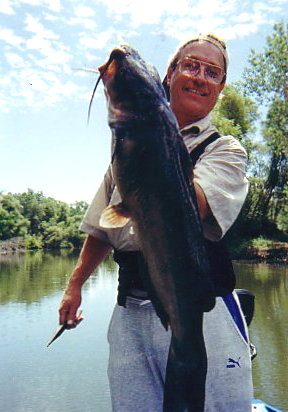| Catfish |
||||||||||||||
 |
|
| Description - Channel
catfish closely resemble blue catfish. Both have deeply forked tails. However, channels have a rounded anal fin with 24-29 rays and scattered black spots along their back and sides. They have a small, narrow head. The back is blue-gray with light blue to silvery-gray sides and a white belly. Larger channels lose the black spots and also take on a blue-black coloration on the back which shades to white on the belly. Males also become very dark during spawning season and develop a thickened pad on their head. Habitat - Most common in big rivers and streams. Prefers some current, and deep water with sand, gravel or rubble bottoms. Channel catfish also inhabit lakes, reservoirs and ponds. They adapt well in standing water where stocked. Feeding
Habits - Feeds primarily at night |
Description - A flattened
head, tiny eyes, squarish tail and protruding lower jaw distinguish the
flathead from other catfish and contribute to it being placed in a
genus of its own. They are yellow-brown and usually mottled above, with
a creamy-white or yellow belly. Small flatheads may be confused with
yellow or brown bullheads. Habitat - Flatheads are found mainly in large rivers and their major tributaries. They prefer long, slow-flowing, moderately-turbid streams. Adult flatheads are solitary and spend most of their time in deep water near cover such as log jams or fallen trees. Feeding Habits - Flatheads are predatory fish and will consume bass, bream, shad, crayfish and often feed on other catfish. The young rely more extensively on aquatic insects and crayfish than do the adults. Large flatheads sometime congregate where food is plentiful such as near tailraces of dams. They often feed at the surface or in shallow water at night, returning to their residence in a hole or brush pile to rest during the day. They rarely eat dead or decaying matter. |
Description - Adult fish have
stout bodies with prominently humped backs in front of the dorsal fin.
They resemble channel catfish by having deeply forked tails, but are
dissimilar because they are unspotted and have a long, straight-edged
anal fin with 30 to 35 rays. The back and upper sides are blue to slate
gray, and the lower sides and belly are white. The internal air bladder
has a constriction in the middle, giving it a two-chambered appearance. Habitat -
Blues occur in big rivers and in the lower reaches of major
tributaries. They prefer clearer, swifter water than other catfish, and
are usually found over sand, gravel or rock bottoms. Their preferred
water temperature is 77 to 82 degrees. |